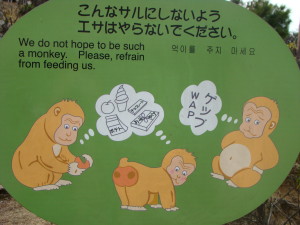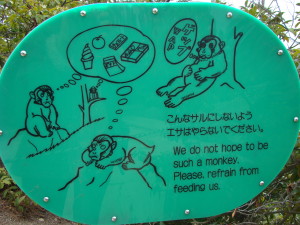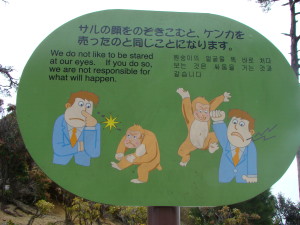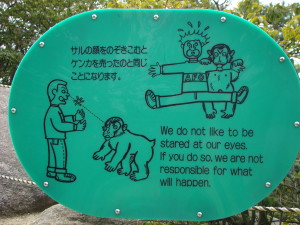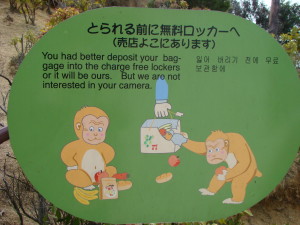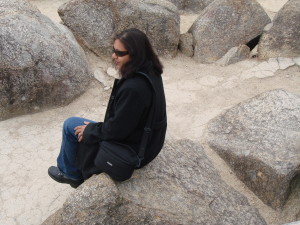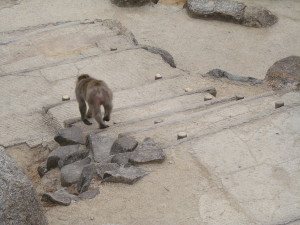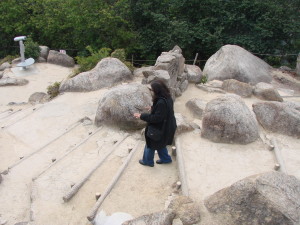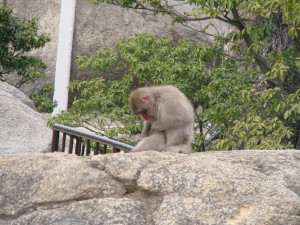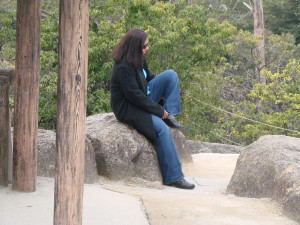A quick ferry south of Hiroshima will take you to the island of Itsukushima (厳島), or as it is more popularly known, Miyajima (宮島), the “shrine island”. People flock there daily to see Itsukushima Shrine, with scenic seaside torii gates that seem to float every day during high tide:

Photo taken during my more recent trip in 2013. Look how pretty it is!
Together with Hiroshima it is also famous for its delicous oysters, plump and juicy and incredibly satisfying, but that’s another story for another day. Today I’d like to share my experiences with an aspect of Miyajima that sadly seems to be there no longer: the Japanese macaque.
Back in 2008, the first time I visited Miyajima, I was in Japan with my family for the wedding of my first Japanese tutor, where I had been invited to say a few words about her. In Japanese. I was incredibly nervous about speaking in front of an all-Japanese audience and having to make my tutor look like her hard work had paid off, so it was nice to spend a week travelling first and seeing some new sights.
Our trip to Miyajima involved a ride on the Miyajima Ropeway up to Mount Misen (弥山), from which we could get a beautiful aerial view of the Seto Inland Sea, and, as it turned out, some close encounters with wild Japanese macaques.
On Mount Misen, my confidence in my Japanese ability quickly went up as I saw some of the adorable Engrish signage concerning the macaques:
- We Do Not Hope to Be Such a Monkey
- We Do Not Hope to Be Such a Monkey
- We Do Not Like to Be Stared at Our Eyes
- We Do Not Like to Be Stared at Our Eyes
- Your Baggage Will Be Ours
As you can see from those warnings, macaques are not the friendliest of animals, and any encounter with them is a mixture of joy and abject terror. When I was living in the mountains of Kochi Prefecture a group of them passed us overhead in the trees and we stayed stock still with fright until they had disappeared from view entirely; we had heard horror stories from friends in the area of one macaque leaping up on someone’s head, and another spitefully urinating on their car. I’m sure that’s not the worst thing to happen to someone stepping afoul of one of these creatures.
As I walked around with my family, enjoying the views and exploring Mount Misen, I noticed something startling: my mother and the macaques were exhibiting similar behaviours during our time on the sacred mountain. Me and my sister decided to document this phenomenon for great science:
- Macaque at rest.
- Mother at rest.
- Macaque on the move.
- Mother on the move.
- Macaque preening.
- Mother preening.
In case you were wondering, both my sister and I are very mature.
In the end we decided that the macaques must have taken a liking to my mother and were trying to ape her every move:
When I visited the island of Miyajima again with a friend in 2013, I was excited to show them the macaques and relive the fun of my last visit. However, all the signage was gone, and there were no macaques in sight anywhere, despite a lengthy search. It was almost as though they had never been there at all. I did some quick research before writing this – apparently they have all been moved to a “monkey centre” in Aichi Prefecture, for better or worse. Originally brought over in 1962 from Kagawa Prefecture to boost tourism, it seems like to the industry they have now overstayed their welcome and were starting to be seen as pests. I won’t lie: that whole situation seems pretty sad to me. And I kind of feel for the little guys. That they were brought purely for tourism and then taken away the moment they were unwanted is to me incredibly telling of how little we value these animals.
Now the only evidence that there were once macaques on Mount Misen (as of 2013) is this “you are here” sign from when they were still plentiful on Miyajima. It’s kind of… well… I’ll just show it to you:
Of course, the oysters are still there. EAT MIYAJIMA OYSTERS. THEY WILL CHANGE THE WAY YOU THINK ABOUT OYSTERS.
For more photos from this particular trip to Miyajima, please check out the album on Flickr here!


